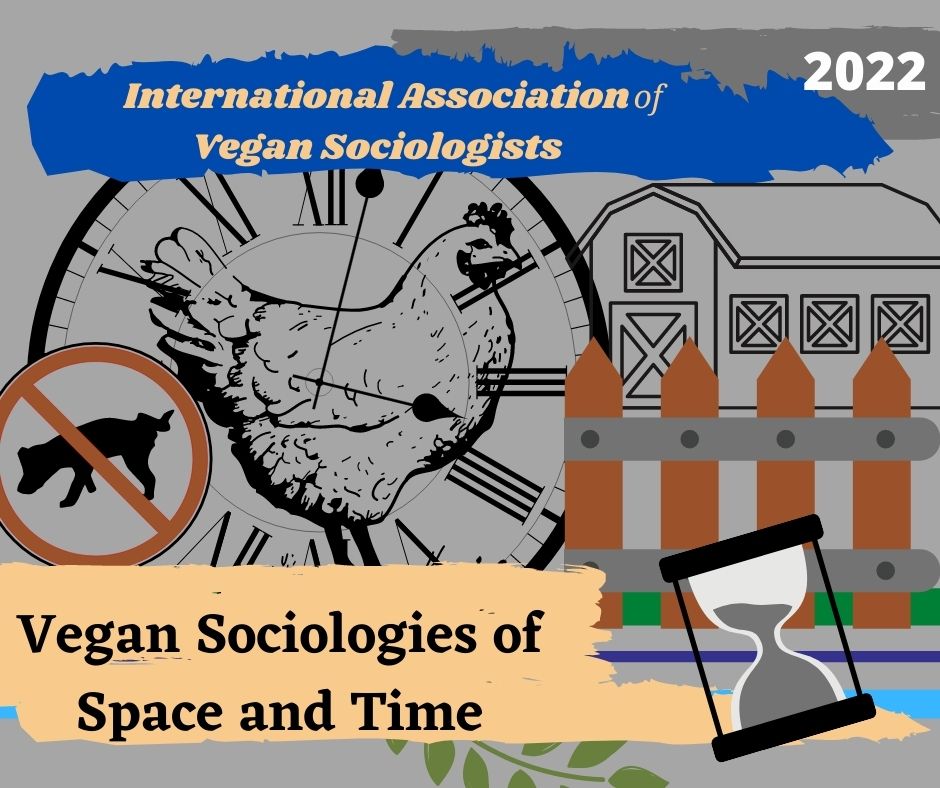Annual Meeting of the International Association of Vegan Sociologists

Title: Vegan Sociologies of Space and Time
Date: October 8 & 9, 2022
Location: Online
nnIn space, what came earlier continues to underpin what follows… not only durable spatial arrangements, but also representational spaces and their attendant imagery and mythic narratives
— Henri Lefebvre, The Production of Space, pp.229-230.As long as time is taken for granted as the mere framework within which action takes place… it will continue to form a central part of the deep structure of environmental damage wrought by the industrial way of life.
— Barbara Adams, Timescapes of Modernity, p.9.
The sociological toolkit has much to offer to critical studies of human-nonhuman animal relations. Significant works have highlighted the influence of broader social structures, discourse, and micro-interaction on the exploitation of other animals (Cole & Stewart 2014, Cudworth 2011, Nibert 2017, Peggs 2012). A complementary strand of the discipline has furthered advocacy efforts through developing understandings of nonhuman animal advocacy and veganism (Bertuzzi 2020, Cherry 2006, Wrenn 2019). Since its conception in 2020, the International Association of Vegan Sociologists has supported the development of scholarship that actively challenges the exploitation of nonhuman animals. In our third annual meeting we draw on two streams of sociological thought — sociologies of space and time — to provoke innovative and fruitful research that furthers this goal.
Sociologists look at space and time as social — constructed in particular ways to maintain social order. Space is physically shaped, for instance with objects, signs and architecture, to direct movement or behaviour in particular ways (sit here, eat in that room, do not feed the wildlife). Time is ordered, e.g. through calendars and clocks, but also shaped through particular habits, tempos and rhythms (such as the speed of a production line). These constructions reflect and reproduce broader social relations, for instance, the tailoring of society around particular bodies makes it more accessible for some than others. Exploitative human-nonhuman animal relations, too, are reproduced in particular spatial and temporal contexts — for instance, the use of anti-dog regulation signs or hostile architecture such as bird spikes demarcating ‘public space’ as human-only; the rapid speed and physical disruption of sight in slaughterhouses to facilitate efficient killing; and the placement of sites of farming and killing animals at the outskirts of cities to remove these elements of exploitation from public consciousness (Arcari et al 2021, Pachirat 2012, Wadiwel 2015). Unpicking these contexts of exploitation creates an opportunity to re-imagine configurations that might foster less-oppressive human-nonhuman animal entanglements in the future.
References
Adam, B. (2005). Timescapes of modernity: The environment and invisible hazards. Routledge.
Adam, B. (2013). Timewatch: The social analysis of time. John Wiley & Sons.
Arcari, P., Probyn-Rapsey, F., & Singer, H. (2021). Where species don’t meet: Invisibilized animals, urban nature and city limits. Environment and planning: Nature and space, 4(3), 940-965.
Bertuzzi, N. (2020). Becoming hegemony: The case for the (Italian) animal advocacy and veganwashing operations. Journal of Consumer Culture, online first.
Cherry, E. (2006). Veganism as a cultural movement: A relational approach. Social Movement Studies, 5(2), 155-170.
Cole, M. & Stewart, K. (2014) Our children and other animals: The cultural construction of human-animal relations in childhood, Ashgate Publishing Company: Surrey, England; Burlington, USA.
Cudworth, E. (2011) Social lives with other animals: Tales of sex, death and love, Palgrave Palgrave Macmillan: London.
Lefevbre, H. (1991 [1974]) The production of space (Donald Nicholson-Smith Trans.). Oxford: Blackwell Publishing.
Nibert, D. (Ed.). (2017). Animal oppression and capitalism [2 Volumes]. ABC-CLIO.
Pachirat, T. (2012) ‘Hidden in Plain Sight,’ pp. 1-19, in Every Twelve Seconds: Industrialized Slaughter and the politics of sight. Yale University Press.
Peggs, K. (2012) Animals and sociology, Palgrave Macmillan: London.
Wadiwel, D. (2015). The war against animals. Brill.
Wrenn, C. L. (2019). Piecemeal protest: Animal rights in the age of nonprofits. University of Michigan Press.
IAVS Conference 2022 Lectures
British Vegaphobia
A Decade of Vegaphobia
Matthew Cole & Karen Morgan
PC-Ravaged Clowns or Plant-Powered Pioneers? An Exploration of UK Newspaper Portrayals of Veganism in 2020
Norm Riley
Selling Veganism in the Age of COVID: Vegan Representation in British Newspapers in 2020
Corey Wrenn
Vegan Spatialities of Domesecrated Animals
Locked up with Companion Animals
Federica Timeto
Spatialities of Constraint: Resisting Anthroparchy in the Context of a Housing Crisis
Zoei Sutton
Veganism as Praxis
Soyboys will be Boys: Exploring the Seemingly Contradictory Identity of Vegan Men in Australia
Alex Hill
Veganism in Religious Spaces and throughout the Religious Calendar
Ellie Atayee-Bennett
Understanding Vegan Transition Experiences through the Narratives of Vegan Men
Kadri Aavik
The Vegan Sociological Lens
Introducing Vegan Sociology to Other Disciplines
Nick Pendergrast and Adam Cardilini
Eating (Non)Violence: An Interdisciplinary Exploration of Race and Veganism
Victoria Brockett
Vegan Standpoint Theory
Jessica Greenebaum
TASA Panel Discussion
Challenging Anthroparchy in Research: on the Socio-spatial “Doing” of Vegan Sociology
Zoei Sutton, Nick Pendergrast, and Alexander Hill
Timescapes of Multispecies Relations
Anthropocentric Histories, Animal Futures
Maria Martelli
A (Brief) History of UK Animal Trials
Lynda Korimboccus
A Very Brief History of the Future: A Transformation Story of Achieving Justice for the More-Than-Human World
Luke Li Stange
PSA Panel
Sharing or Dividing: Discussion around Fences in Natural Environment
Hanna Mamzer
Discovering Death in Nature
Lucja Lange
Recognizing Animal Sentience: New Definition of Being ‘Civilized’ in the 21st Century?
Adrianna Kapek-Goodridge